(PDF) Comparative analysis of banking
Added on 2019-11-14
33 Pages7693 Words171 Views
Running head: FINANCIAL COMPARISION BETWEEN BANKSFinancial Comparison between Standard Chartered Bank and United Overseas BankName of the University:Name of the Student:Authors Note:
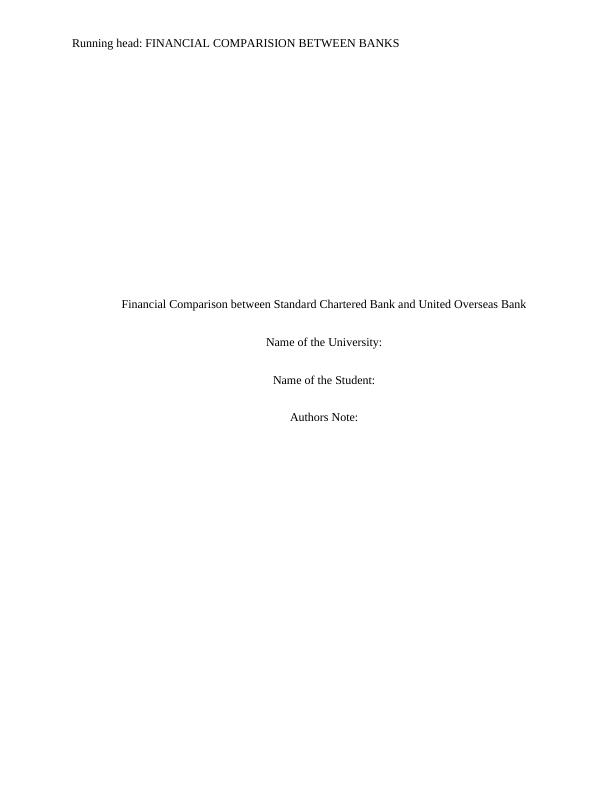
1FINANCIAL COMPARISION BETWEEN BANKSTable of Contents1. Introduction..................................................................................................................................31.1. Research Background...........................................................................................................31.2. Company Background..........................................................................................................31.3. Research Significance...........................................................................................................42. Literature Review........................................................................................................................52.1. Financial Analysis Concept..................................................................................................52.2. Financial Ratios Concept......................................................................................................52.3. Use of Financial Ratios in Banks..........................................................................................62.3.1. Credit Loss Ratio...........................................................................................................62.3.2. Cost/Income Ratio.........................................................................................................72.3.3. Net Interest Margin Ratio..............................................................................................82.3.4. Earnings per Share Ratio...............................................................................................82.3.5. Return on Equity............................................................................................................82.3.6. Capital Adequacy Ratio.................................................................................................93. Research Questions and Objectives...........................................................................................103.1. Research Questions:............................................................................................................103.2. Research Objectives............................................................................................................104. Research Methodology..............................................................................................................10
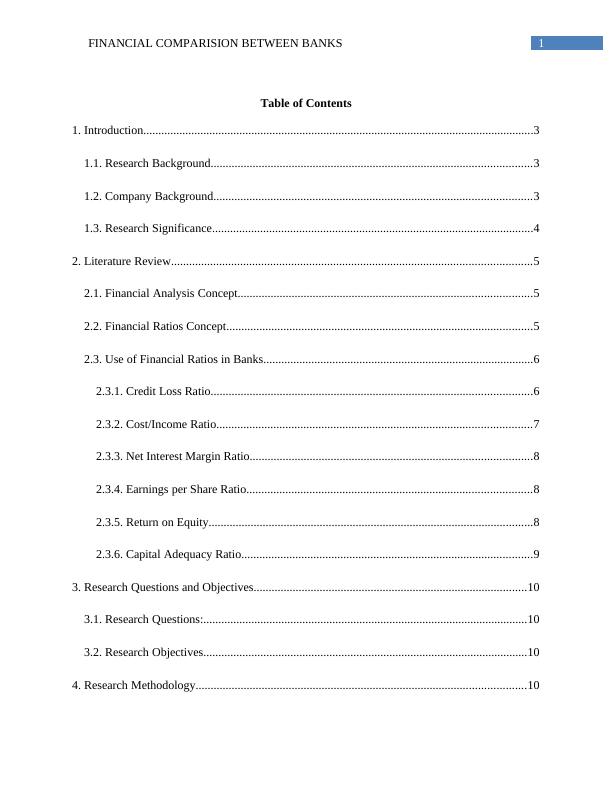
2FINANCIAL COMPARISION BETWEEN BANKS4.1. Research Design.................................................................................................................104.2. Data Collection...................................................................................................................114.3. Data Analysis......................................................................................................................124.4. Limitations..........................................................................................................................124.5. Reliability and Suitability...................................................................................................125. Findings and Analysis................................................................................................................145.1. Financial Statements of Standard Chartered Bank and United Overseas Bank.................145.1. Credit Loss Ratio Analysis.................................................................................................205.2. Cost/Income Ratio Analysis...............................................................................................215.3. Net Interest Margin Ratio Analysis....................................................................................225.4. Earnings per Share Ratio Analysis.....................................................................................245.5. Return on Equity Ratio Analysis........................................................................................255.6. Capital Adequacy Ratio Analysis.......................................................................................276. Conclusion and Recommendations............................................................................................286.1. Conclusion..........................................................................................................................286.2. Recommendations to Banks...............................................................................................29Reference List................................................................................................................................31
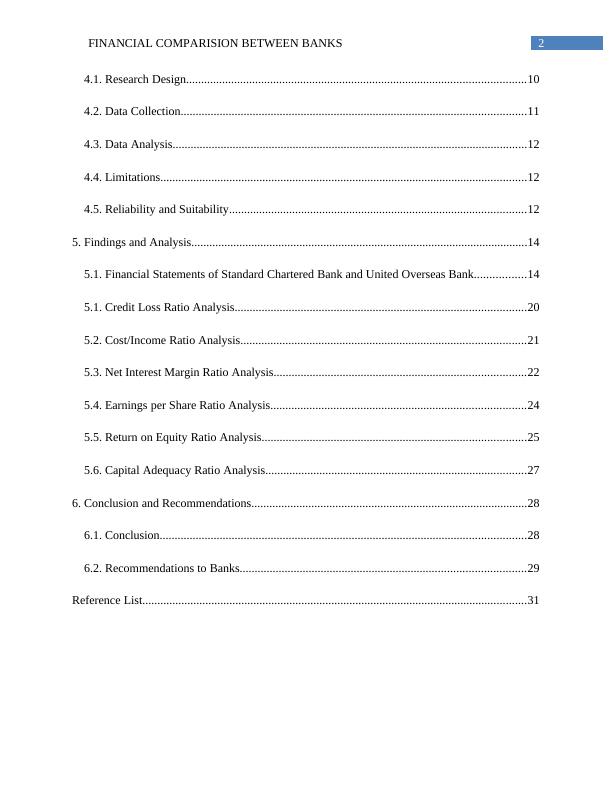
3FINANCIAL COMPARISION BETWEEN BANKS1. Introduction1.1. Research BackgroundIn economic improvement, banks serves as critical part for the economy as these arefundamental financial interlinks that facilitate borrowing and lending exercises within indirectmarket. In the event that banks might not fit well within industry, it might contribute to hugefailure within the economy (Altman 2013). Commercial banks (CBs) are different from otherpartnership organizations as they have unique components within the assets and liabilitiessection. Then again, same as few organizations, the business operation of CBs are measured bythe basic offer that they issue to their investors. 1.2. Company BackgroundStandard Chartered Bank Plc (alluded as "the bank") is among the renowned commercialbanks that has it’s headquarter in London, UK. The bank is set up after The Standard Bankmerger with The Chartered Bank in 1969. Standard Chartered Bank Plc obtained StandardChartered Merchant Bank Asia Limited in 1985, Korea First Bank in 2005, ANZ Grindlays Bankin 2000 and American Express Bank Ltd in 2008. Starting at 30 June 2010, the aggregateresource of Standard Chartered Bank Plc achieved USD 480.8 billion and is positioned ninth inUK. The bank had acquired 18.4% of Temasek Holdings and 6.2% of Blackrock Inc (Altman2013). UOB is positioned among the renowned banks that has set up itself as a main and localbank in Singapore and in Asia through business acquisitions. Today, the UOB Company has itsbusiness operations worldwide in 19 nations within Asia Pacific, Western Europe and NorthAmerica - having a system of more than 500 workplaces. Singapore, Malaysia, Indonesia,
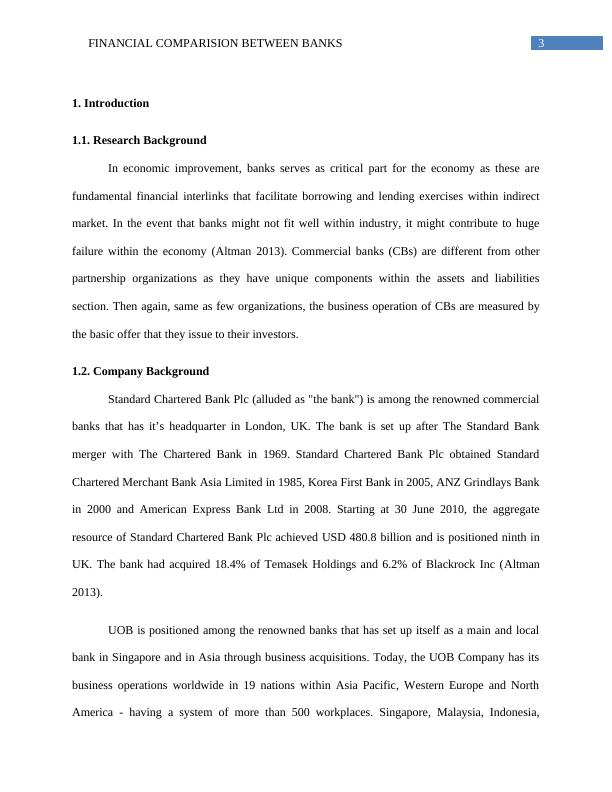
4FINANCIAL COMPARISION BETWEEN BANKSThailand and China are managing an account backups of UOB. UOB offers a broad range offinancial services through its international business partners (Avkiran 2011). The company offersconsumers with access to financial services like private management of an account, individualmoney management, business and corporate money saving.1.3. Research SignificanceThe financial performance of the commercial banks is required to be assessed andfinancial ratio analysis serves as an effective measure to evaluate the bank performance in thecurrent paper. In addition, there are many causes due to which such financial condition becomesmore intensified, for example, fluctuation on loan fees and external trade rates, liquidity hazard,decreasing society dependence through financial framework, confinement within lendingexercises and decreased financial movement. In a situation of loss on operation or workingcapital deficiency, the company can use the information from its annual report to make effectivebusiness decisions (Barathi Kamath 2017). In such scenario, ratio analysis is considered to be aneffective analysis that can signify the financial position of the company. In addition the ratioanalysis demonstrates a connection between all the elements in income statement or balancesheet or can help in analyzing the profitability or loss trend within the financial statements.Along these lines, in this analysis, it will look out which financial ratios must be utilized in thecompany to counteract bank failure. A research report regarding "Forecast of bank failure" takenfrom Aggarwal, Paruthi and Kumar (2014) will be adjusted and those important financial ratiosare likewise at that point to be clarified in this analysis.
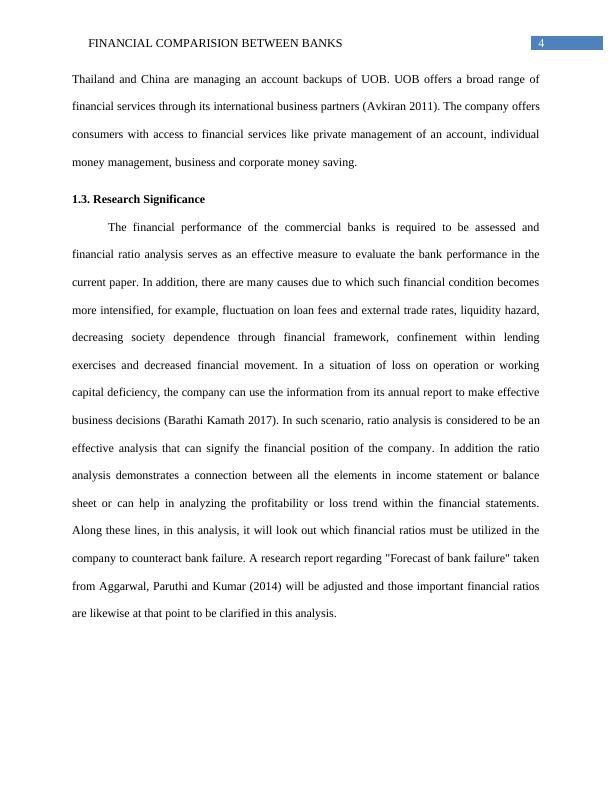
5FINANCIAL COMPARISION BETWEEN BANKS2. Literature Review2.1. Financial Analysis ConceptFinancial analysis is observed to give supplementary information for various leaders. ASeveral indicators including an analysis in light of characteristics and effects on economyfocused organizations will be sought out or discovered and utilized in investigation cash process.A lot of indicators are given to settle on choice regarding picking the vital operating exercisestool along with choosing sorts of venture that must be to be financed (Beaver, Correia andMcNichols 2012). Along these lines, an idea has been turned out in the procedure of financialinvestigation that financial ratios, designs or certain strategies was decided for analyzing. In thisway, the indicators are then to research the implementation of the major aspect in deciding. 2.2. Financial Ratios ConceptKeeping in mind the end goal to assess the performance of depository organizations,financial proclamations of commercial banks manages wide range of accessible financial data forpublic. In contrast with financial explanation accounts, financial ratios are less demanding toclarify an organization’s business operation as in financial reports. In addition, financial ratiosare dependably a significant measurement when they work out with an analysis or a reason forreviewing changes in propensity; or the consequences will be severe, a ratio itself is an un-significant number in light of the fact that the ratios utilized as a part does not totally explain thebusiness performance of the company (Berger et al. 2012). Organization analyses those ratios atthat point to compare them and develop standard ratios for itself or different organizations in asimilar industry. This helps in analyzing the organization's propensity by utilizing same ratioover a long time that is picked arbitrarily relying upon organization needs.
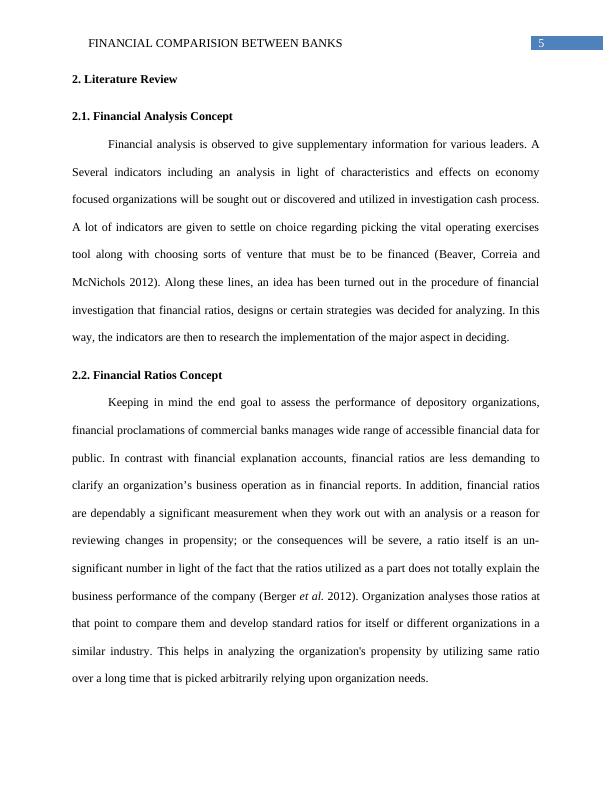
6FINANCIAL COMPARISION BETWEEN BANKSApplying pertinent financial ratios, is an approach to screen an organization's position bydrawing out the outcome on how the organization effectively created stores and benefits. Asindicated by the ratios with a year based investigation (financial proclamation is examined in aparticular time), it perfectly secured the count by alluding the measurement taken from anassociation's financial explanation, with the goal that those ratios can demonstrate anorganization financial status. The correlation which utilizes organization's comparable ratios in aportion of year is deemed as cross-sectional analysis (Bhattacharyya, Lovell and Sahay 2013).Cross-sectional analysis utilizes organization's comparative ratios in a portion of years to do acorrelation. Despite utilizing several financial analysis techniques, ratio analysis is attempting togive a portrayal of organization's strengths and shortcomings for assessing the vital part on offinancial situation of the company. In this way, those data offers a few chances for financialspecialists, experts and supervisors to conduct a ratio analysis before settling on a choice.2.3. Use of Financial Ratios in BanksBanks are financial organization, despite the fact that they are also financialestablishments, which offers detailed financial data different from other financial establishments.Inclination of economy acts as vital part that affects banks' benefits, as banks' income majorlyoriginate from the cash they have in net premium salary. This is an aspect based on which theloan costs rely upon the financial condition, so the interest free margin can be kept up as high asit could. "Expectation of bank collapse", the example has drawn a perfect decision based on sixfinancial ratios clarified in this analysis.2.3.1. Credit Loss RatioCredit loss ratio signifies changes on liquidity are a critical change to be expected. Inaddition, defaulting credits are vital to be considered than liquidity changes. Credit loss ratio can
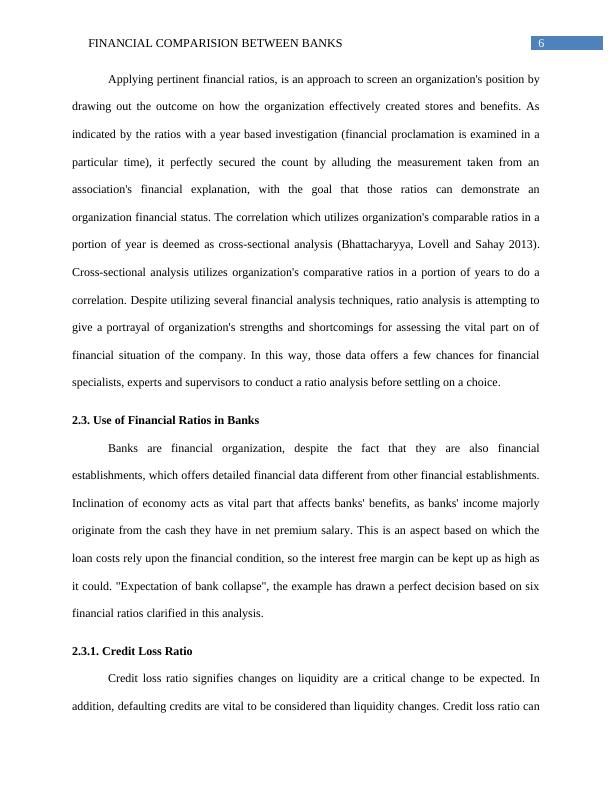
7FINANCIAL COMPARISION BETWEEN BANKSbe understood as ratio which signifies net measure of credit faults remains connected inaggregate sum of bank offering with borrowers. It is an attainment rate that remains decreasedthan one within ratio. Credit loss ratio= Net credit loss/Total lending At the point the banks considered lending exercises; it is conceivable to realizeimportance of credit loss. By taking a look at credits, bank will expect that most of them will endup being a default installment. In estimation of banks' benefit before charge, banks might followconceivable costs. Consequently, banks were ensured that when borrowers neglect to pay; theyremain within controller capital necessity along with financial commitments. Negative situationhas appeared to bank's business at the time credit loss was increased (Chaudhary and Sharma2011). Conversely, an analysis in credit loss will be done with different banks through explainingcredit loss over aggregate lending. By focusing on default credits, it can be said that moreprominent the bank can deal with aggregate lending, the more littler the rate will be observedwithin this ratio.2.3.2. Cost/Income RatioThe second ratio within exploration shows critical connection among operating incomealong with operating costs. This ratio measures the effective way in which bank has a capacity tomanage working costs by producing operating income. In this way, this ratio will be looked formaintaining a high ratio under such circumstances (Malhotra and Singh 2016). Income/Cost ratio= Income/Cost Cost-to-income ratio is all the regularly utilized by bank to show operationaleffectiveness after financial emergency that happened. In this ratio, bank's capacity is not to
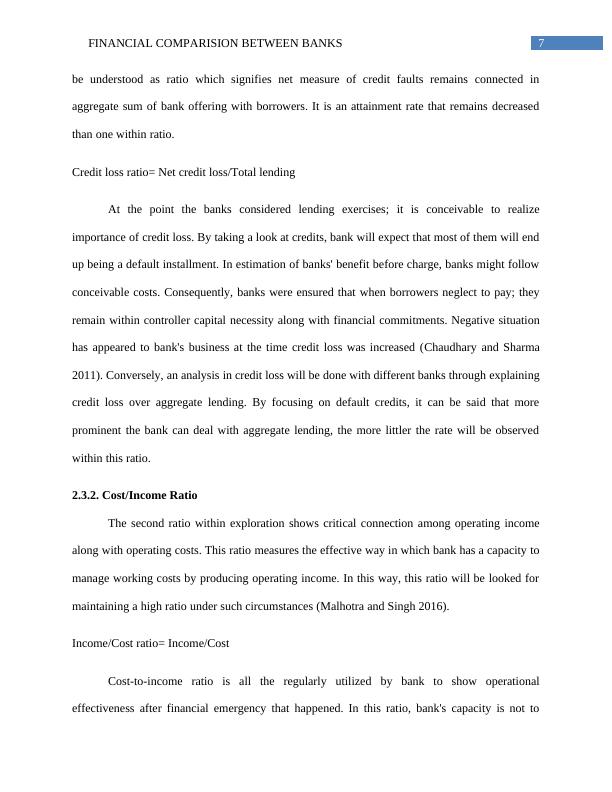
End of preview
Want to access all the pages? Upload your documents or become a member.
